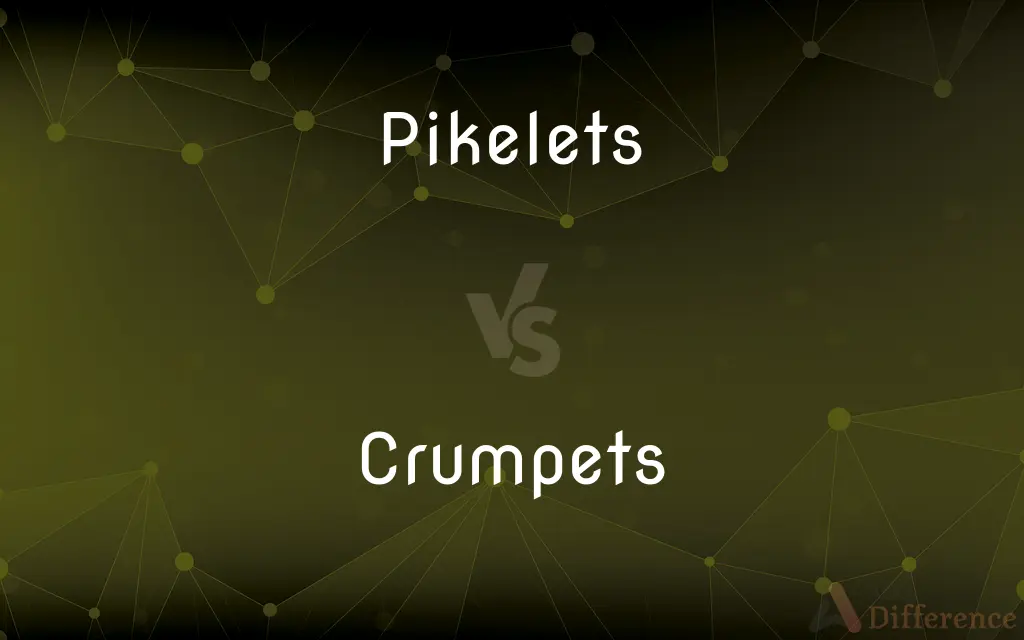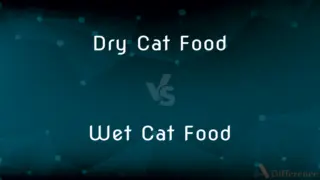Pikelets vs. Crumpets — What's the Difference?
Edited by Tayyaba Rehman — By Maham Liaqat — Published on February 21, 2024
Pikelets are small, thin pancakes popular in Australia and New Zealand, like American pancakes but smaller and thicker. Crumpets are thicker, spongy cakes with a chewy texture, characterized by their holes on the top, made from a yeast-leavened batter.

Difference Between Pikelets and Crumpets
Table of Contents
ADVERTISEMENT
Key Differences
Pikelets and crumpets are both griddle cakes enjoyed in different parts of the world, with distinct characteristics setting them apart. Pikelets, akin to mini pancakes, are made from a batter similar to that of pancakes, containing flour, eggs, milk, and a leavening agent, resulting in small, fluffy, and slightly thick rounds that are cooked on a griddle or frying pan. They do not require ring molds for cooking and have a smooth surface with no holes, making them ideal for spreading with jam, cream, or butter.
Crumpets, on the other hand, are a British culinary staple known for their unique texture and appearance. The batter for crumpets includes flour, water or milk, and yeast, which causes the batter to rise and create air bubbles. These bubbles burst during cooking, leaving the characteristic holes on the top surface of the crumpet. Crumpets are traditionally cooked in ring molds to maintain their shape and thickness, and they are known for their spongy and slightly chewy texture, perfect for absorbing butter and other toppings.
Pikelets can be served either warm or cold and are often enjoyed as a snack or breakfast item with sweet toppings, while crumpets are usually served toasted with butter, jam, or honey, often as part of a traditional afternoon tea.
The choice between pikelets and crumpets often comes down to personal preference and the occasion, with pikelets offering a quick, pancake-like option and crumpets providing a distinct texture and taste that pairs well with a hot cup of tea.
Comparison Chart
Origin
Australia and New Zealand
United Kingdom
ADVERTISEMENT
Batter Ingredients
Flour, eggs, milk, leavening agent
Flour, water or milk, yeast
Texture
Fluffy and slightly thick
Spongy and chewy with holes
Cooking Method
Cooked on a griddle or pan, no molds required
Cooked in ring molds to retain shape and allow for hole formation
Surface
Smooth, without holes
Porous top with characteristic holes
Serving Temperature
Can be served warm or cold
Typically served warm or toasted
Common Toppings
Jam, cream, butter
Butter, jam, honey
Occasion
Snack, breakfast
Afternoon tea, breakfast
Compare with Definitions
Pikelets
Versatile in serving options.
Pikelets were packed for the picnic, both plain and with various sweet spreads.
Crumpets
Thick, spongy cakes with a distinctive holey texture from the UK.
Toasted crumpets with butter were a staple on chilly afternoons.
Pikelets
Miniature, fluffy pancakes popular in Australia and New Zealand.
Pikelets were served with jam and cream at the morning tea.
Crumpets
Yeast-leavened batter creates air bubbles that form holes.
The crumpet batter rose overnight, ready to cook for breakfast.
Pikelets
Made from a simple, leavened batter.
She whipped up a batch of pikelet batter for a quick breakfast.
Crumpets
Requires ring molds for cooking.
She poured the batter into ring molds, ensuring perfectly shaped crumpets.
Pikelets
Cooked without molds for a freeform shape.
The pikelets bubbled as they cooked, turning golden brown on the griddle.
Crumpets
Traditionally paired with tea.
Afternoon tea wasn't complete without a plate of warm crumpets and clotted cream.
Pikelets
A casual, comforting snack or breakfast item.
Weekend mornings were made for homemade pikelets with a drizzle of honey.
Crumpets
Best enjoyed toasted to enhance their chewy texture.
The crumpets were toasted until the edges were crispy, then slathered with butter.
Crumpets
A small flat round of bread, baked on a griddle and usually served toasted.
Common Curiosities
Can pikelets be used as a substitute for crumpets?
While pikelets can be a substitute in terms of serving with similar toppings, they won't replicate the unique spongy texture and holes of crumpets.
Are crumpet rings necessary for making pikelets?
No, pikelets are typically cooked freeform without the use of rings, leading to their smaller and more irregular shape compared to crumpets.
Can pikelets be toasted like crumpets?
Pikelets can be toasted, although they're commonly enjoyed fresh and soft; toasting can give them a slightly crispier edge, similar to reheating pancakes.
What's the best way to store leftover pikelets and crumpets?
Both can be stored in an airtight container at room temperature for a couple of days or frozen for longer storage. Toast or reheat in a toaster or oven to refresh.
Can you make savory versions of pikelets and crumpets?
Yes, both can be adapted for savory variations; pikelets might include ingredients like cheese or herbs, and crumpets can be topped with savory spreads or used as a base for eggs and bacon.
Why do crumpets have holes on the top but not pikelets?
The holes in crumpets are formed by air bubbles from the yeast fermentation process, whereas pikelets, made with a quicker, non-yeasted batter, typically have a smooth surface.
Are pikelets or crumpets healthier?
The healthiness can vary based on ingredients and toppings. Crumpets may have slightly more caloriies due to their density and yeast content, but both can be part of a balanced diet if consumed in moderation and paired with healthy toppings.
How do you achieve the perfect consistency for pikelet and crumpet batter?
For pikelets, the batter should be thick enough to hold its shape on the griddle but thin enough to spread slightly. For crumpets, the batter should be thick and gloopy, akin to a thick pancake batter, to ensure it stays within the rings and allows bubble formation.
Is there a significant taste difference between pikelets and crumpets?
The taste may be similar due to common ingredients like flour and milk, but the yeast in crumpets can add a subtle depth, and their texture absorbs toppings differently, affecting the overall flavor experience.
How do the cooking times compare between pikelets and crumpets?
Pikelets generally cook faster due to their thinner size and lack of yeast, while crumpets require more time to allow the yeast to create bubbles and for the thicker batter to cook through.
Are there any cultural traditions associated with pikelets and crumpets?
Pikelets are often associated with teatime or as a snack in Australia and New Zealand. Crumpets are a quintessential part of British teatime and are traditionally served with tea.
Can the batter for pikelets and crumpets be made in advance?
Pikelet batter can be made a few hours in advance and stored in the refrigerator. Crumpet batter, due to the yeast, benefits from resting to allow fermentation, making it suitable for overnight preparation.
What's the role of sugar in pikelet and crumpet recipes?
Sugar in pikelet recipes adds a hint of sweetness and helps brown the surface. In crumpets, sugar can provide food for the yeast, aiding in fermentation, but it's not always necessary for the batter.
Is it possible to cook crumpets without a stovetop griddle?
Yes, you can use a non-stick frying pan if a griddle isn't available. The key is to maintain a consistent, moderate heat to allow the crumpets to cook through and develop holes.
What is the best way to serve pikelets and crumpets to guests?
Serve pikelets stacked with a selection of spreads like jam, honey, and whipped cream on the side. Crumpets are best served warm, toasted with butter melted into the holes, alongside a variety of toppings for guests to choose from.
Why might someone prefer pikelets over crumpets, or vice versa?
Preference could depend on texture and taste desires; those who enjoy a light, fluffy texture might prefer pikelets, while those who like a denser, spongy texture with a unique ability to soak up toppings might choose crumpets.
Do pikelets and crumpets require any special ingredients that might not be in a standard pantry?
Pikelets use standard pancake ingredients, which are commonly found in most pantries. Crumpets require yeast, which might not be a staple in every kitchen but is readily available in most grocery stores.
Can dairy-free alternatives be used in pikelets and crumpets?
Yes, milk alternatives like almond, soy, or oat milk can be used in both pikelets and crumpets, though the flavor and texture might vary slightly from the traditional recipes.
How do you know when to flip a pikelet on the griddle?
Pikelets are ready to flip when bubbles form on the surface and the edges look set, similar to pancakes. Unlike pancakes, crumpets are not flipped during cooking.
Can whole wheat flour or other flour alternatives be used in pikelets and crumpets?
Whole wheat flour can be used in pikelets for a healthier option, though they may be denser. For crumpets, using whole wheat flour could affect the texture and rise, so it's typically used in combination with white flour to maintain the traditional texture.
Share Your Discovery

Previous Comparison
Elastic Collision vs. Perfectly Elastic Collision
Next Comparison
Dry Cat Food vs. Wet Cat FoodAuthor Spotlight
Written by
Maham LiaqatEdited by
Tayyaba RehmanTayyaba Rehman is a distinguished writer, currently serving as a primary contributor to askdifference.com. As a researcher in semantics and etymology, Tayyaba's passion for the complexity of languages and their distinctions has found a perfect home on the platform. Tayyaba delves into the intricacies of language, distinguishing between commonly confused words and phrases, thereby providing clarity for readers worldwide.














































